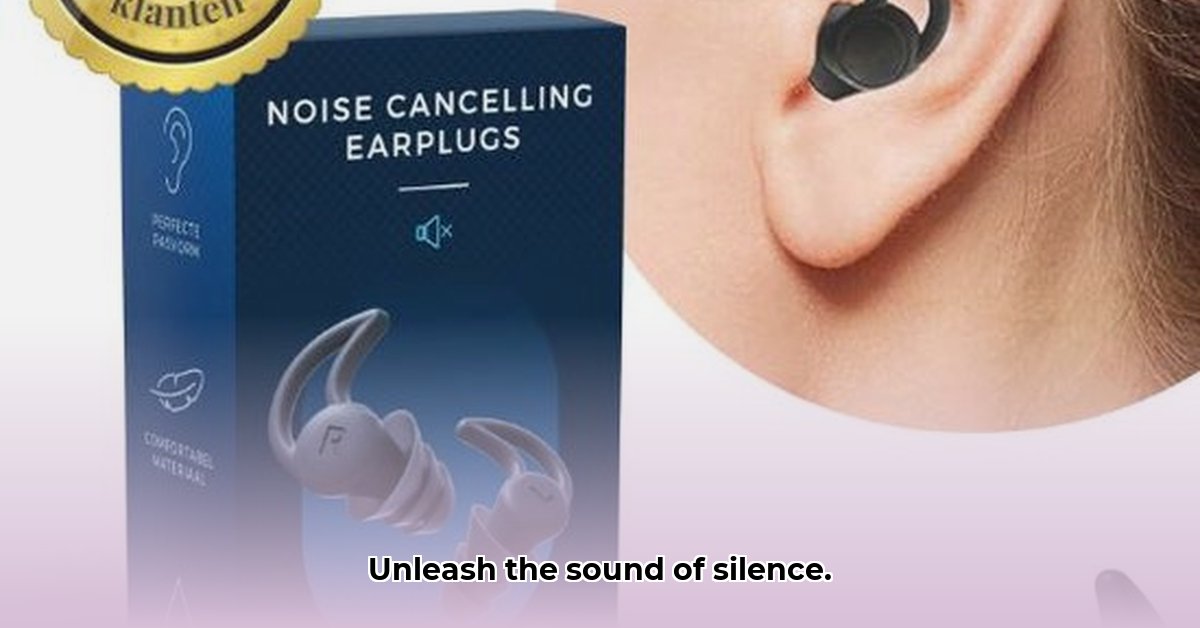
Finding the right earplugs (oordopjes) can transform your sleep, silencing snoring partners, city traffic, or even a noisy neighbour’s dog. But with so many options on the market, choosing the best pair can feel overwhelming. This guide cuts through the noise (pun intended!), helping you find the perfect oordopjes for a peaceful night's rest.
Understanding Your Sleep Needs and Noise Levels
Before diving into specific products, consider your unique sleep environment and noise sensitivity. Are you a light sleeper easily disturbed, or do you need heavy-duty earplugs to block out significant noise? Do you share your bedroom, live in a bustling city, or reside in a quiet suburb? Your answers will dictate the type and level of noise reduction you need. A quiet suburban home might only need modest noise reduction, while a city apartment might demand significantly more.
Decibels (dB): Measuring Noise Reduction
Earplugs are rated in decibels (dB), representing the amount of sound they reduce. A higher dB rating means more noise reduction. A reduction of around 20dB is often sufficient for everyday noises, but louder environments might require a higher rating, perhaps 30dB or more. Remember that lab test results might differ from real-world performance.
Types of Sleep Earplugs: A Comparison
Different earplugs cater to various preferences and budgets. Here's a quick overview:
| Earplug Type | Pluses | Minuses |
|---|---|---|
| Foam Earplugs | Affordable, readily available, generally comfortable | Not durable, need frequent replacement |
| Silicone Earplugs | Reusable, durable, often hypoallergenic | Can be more expensive, may not fit all ears perfectly |
| Custom-Molded Earplugs | Best fit and noise reduction, long-lasting | Most expensive, requires professional fitting |
Choosing the right type depends on your budget, needs, and tolerance for maintenance. Foam is great for a quick, affordable solution, while silicone offers reusability and durability. Custom-molded plugs provide superior noise reduction but represent a larger investment.
Material Matters: Comfort and Hygiene
The material significantly impacts comfort and hygiene. Silicone is popular for its durability and hypoallergenic properties, although some find it less comfortable than softer materials. Foam earplugs are often softer, but their disposability contributes to waste. Regularly cleaning reusable earplugs is crucial to prevent wax buildup and potential infections. The choice boils down to personal preference and practicality.
Potential Issues: Allergies and Infections
While generally safe, some individuals might experience allergic reactions to silicone. A small patch test before extended use is advisable if you have concerns. Improper use of earplugs, especially high-decibel types, could also risk hearing harm. With foam earplugs, failing to change them frequently enough can lead to bacteria buildup and potential ear infections.
Choosing the Right Earplugs: A Step-by-Step Guide
Finding the perfect oordopjes is a personal journey. Follow these steps to find your ideal fit:
- Assess your noise sensitivity: How much noise truly bothers you at night?
- Identify noise sources: Pinpoint the specific noises disturbing your sleep (snoring, traffic, etc.).
- Set a budget: Decide how much you're willing to spend.
- Read online reviews: Learn from other users' experiences.
- Experiment with different types and sizes: The perfect fit is paramount for comfort and effectiveness.
Choosing the right earplugs is crucial for a good night's sleep. Investing time in finding your perfect fit will pay off in improved rest and overall well-being. Sweet dreams!
How to Choose the Best Sleep Earplugs for Side Sleepers
Side sleepers often face unique challenges, needing earplugs that provide comfort and effective noise reduction without creating pressure points.
Material Considerations for Side Sleepers
- Memory foam: Moulds to the ear for comfort, but is disposable.
- Silicone: Durable and reusable, but may feel firm to some side sleepers.
- Wax: Offers a soft, malleable fit, but needs careful cleaning.
The ideal material depends on your personal comfort levels.
Noise Reduction and Fit: Prioritising Comfort
While a high Noise Reduction Rating (NRR) is desirable, a comfortable fit is even more critical. A poorly fitting earplug, regardless of its NRR, might not block noise effectively. For most side sleepers, an NRR of 20-25 dB should suffice for moderately noisy environments.
Minimising Pressure for Side Sleepers
Look for earplugs with:
- Tapered or flanged designs: These minimise ear pressure.
- Multiple sizes: Ensuring a precise fit is crucial.
- Visibility: Bright colours or glow-in-the-dark options aid in locating them at night.
A comfortable fit is paramount for undisturbed sleep.
Hygiene Practices for Side Sleepers
Regular cleaning of reusable earplugs is vital to prevent infections and wax buildup. Disposable options offer convenience but increase waste. Choose the option that best suits your lifestyle and hygiene practices.
A Step-by-Step Guide for Side Sleepers
- Analyse your noise environment: Determine the required NRR.
- Select your material: Prioritise comfort and reusability.
- Choose the right size and design: Opt for tapered, flanged designs with multiple size options.
- Test before bedtime: Ensure a comfortable fit throughout the night.
- Establish a cleaning routine (if using reusable earplugs): Maintain hygiene to prevent infections.
Remember, choosing the perfect earplugs is a personal quest. Experimentation and careful consideration of your individual needs will lead you to the oordopjes that ensure peaceful sleep.